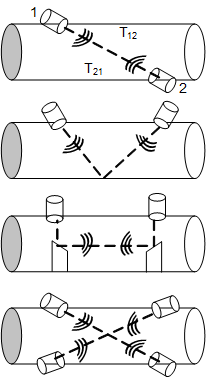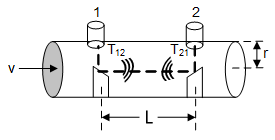SLAA889A March 2019 – July 2021 MSP430FR6041 , MSP430FR6043 , MSP430FR60431 , MSP430FR6045 , MSP430FR6047 , MSP430FR60471
1 Flow Metering Background
This document describes the ultrasonic time-of-flight (TOF) based algorithms for water flow measurement. Figure 1-1 shows different configurations that are used in practice for the ultrasonic TOF technique.
 Figure 1-1 Configurations for Ultrasonic TOF Based Measurement
Figure 1-1 Configurations for Ultrasonic TOF Based MeasurementThis document uses the structure in Figure 1-2 for analysis of ultrasonic TOF techniques.
 Figure 1-2 Transmit and Receive Transducers for Ultrasonic Measurements
Figure 1-2 Transmit and Receive Transducers for Ultrasonic MeasurementsIn Figure 1-2, the two transducers are numbered 1 and 2, T12 is the propagation time for the ultrasonic signal from transducer 1 to 2, and T21 is the propagation time for the signal from transducer 2 to 1. Equation 1 and Equation 2 calculate the propagation times in the two directions as a function of the velocity of ultrasound in water and the velocity of water flow. The parameters in the equation are c = velocity of ultrasound in water, v = velocity of water flow, and L = the propagation length of the pipe along the flow of water. Because this length is much larger than the radius r of the pipe, the propagation length of the wave perpendicular to the flow is neglected in this analysis.
The objective is to solve for the velocity v of the water flow so that can be used to indicate the water flow volume which would be given by volume = A × v, with the assumption that the cross sectional area A of the pipe is known.
Equation 3 calculates the differential TOF of the upstream and downstream signals.